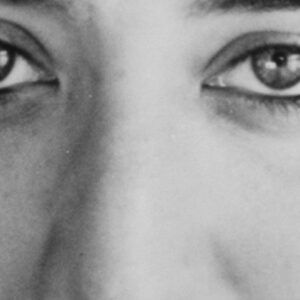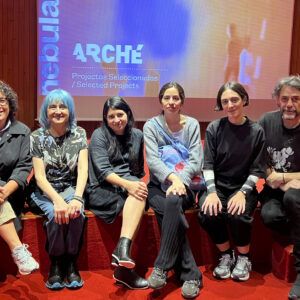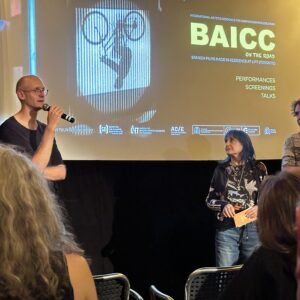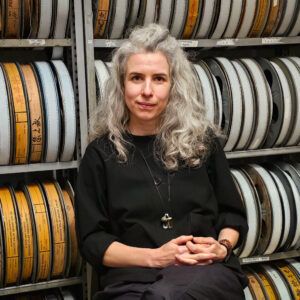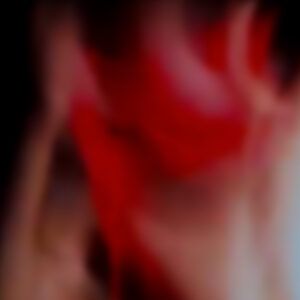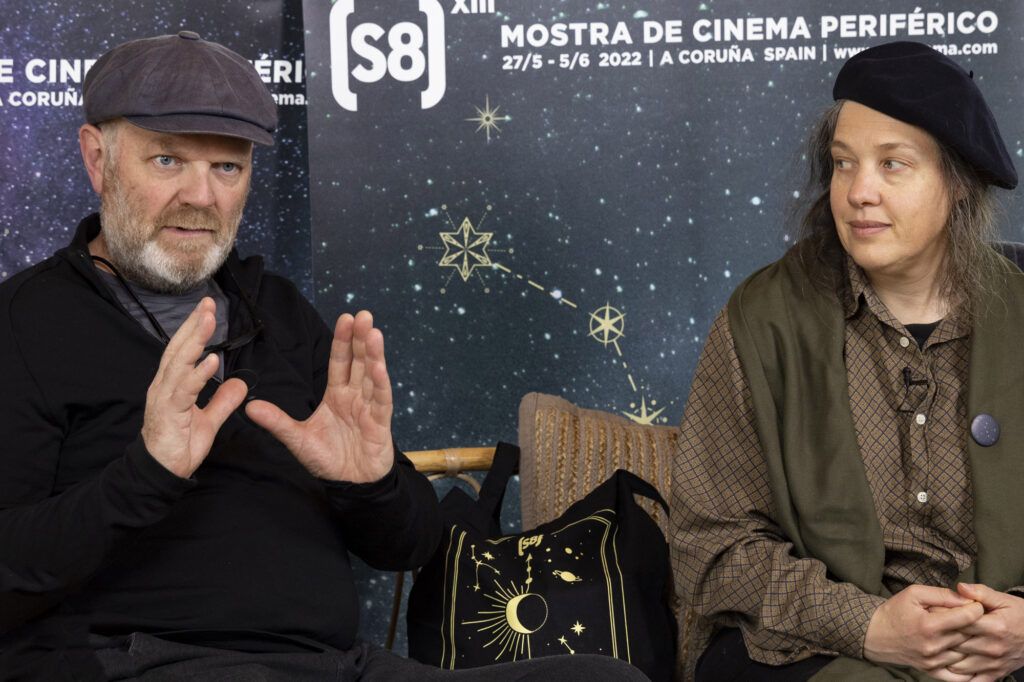
Your films are very much linked to optical and photochemical processes. How did this way of working evolve?
Dianna: Many of the Super 8 films became almost films about the camera’s possibilities. We would do a lot of things frame-by-frame, the small amount of double exposure you can do on Super 8, multi-image filters, playing with the macro… Doing the chemistry ourselves, getting the prints ourselves… We were also exploring the other possibilities there were, other than just developing the film or printing it normally.
Richard: Early on someone said after watching a whole lot of our films that they were films about cameras, which at the time offended me a bit, because that’s not how I saw it. More recently, Paul Clipson told us something very similar about his work. He came to Australia and did a screening where he described his films as “manuals on the Super 8 camera”. And I thought, “Oh, yes, they are, and they’re great!”
Yes, but even though the films are very much related to the technical side, I think they are also related to philosophy, am I right?
Richard: Yes, I think you can draw a connection, at least I can, between a philosophical background and what’s going on in our work. In part, our philosophical education was in Anglo-American philosophy, which is very meticulous, not contemplative or speculative; it’s a very analytical type of philosophy where you break down sentences. I feel that that strictness, that tough education is definitely connected to the kind of work we find satisfying in film, the kind of work that we want to see in a film. The other connection I make is with the Ozu-type films I was trying to make; very minimalist and formalistic, related to that formalistic and minimalist philosophy. And the cinema I was interested in early on was minimalist and formalistic. And I think that is there, in the films we are trying to make. It’s satisfying for us when there’s a minimum set of parts, and we can roll out something more complex from it. That’s the point in where find the most satisfaction.
I think there’s something about the structure of the films that has to do with what you just said, but also with musical structures: loops, variations…
Dianna: Yes, I certainly find that the process of editing is like composing. I work creating some material and editing from this material. Firstly with found footage, which I can’t find anymore, rather than starting with “Oh, I need this or that” and going to film some more. It tends to be a process in which I collect things to find out how I can use them to compose something that would carry an audience through a complete duration.
Richard: The idea of structure is important to us, because music is a 100% time-based medium. Not 100%, but close.
Dianna: Well, sound is variations in pressure over time.
Richard: We are very much aware of the experience in the darkened hall; we want to create some structure that holds up, that has a kind of musical integrity. It’s hard to draw an analogy between music and cinema; it’s more something you do through gestures, but it’s definitely on our minds. Especially something like a quartet or just one movement of a sonata. That’s the kind of structure we fantasize about, as opposed to being concerned about something less experiential. We’re interested in the way sections of things relate to each other in terms of bodily experience. We’re not structuring things in terms of emotion, for instance, but rather in terms of other kinds of characteristics like rhythm or light and shade or whatever it might be.
Besides the more visual component, I also find the sound of your films very interesting. Can you tell me a little about that?
Dianna: The soundtracks are interesting. We usually start to work on them when the picture is pretty well finished. My aim with them is to give you a sense of an arc, some sort of ongoing texture, development or something. But we like to think of it as falling short of being a complete piece of music; you still need the image for it to be complete. Sometimes that means doing something with a very small amount of sound that keeps repeating. Often, if the picture is already doing that it means doing something with a much longer arc that isn’t repeating the same sound over and over. So we sometimes move between very long arcs of constantly new material and small elements that repeat over and over. We create the right counterpoint with the picture. Often we try several soundtracks; there’s always something interesting happening. It’s always different with every project.
Richard: More than once we have used one soundtrack in various projections and then we do a new one for it.
Dianna: Because it’s always different when you actually show it to an audience. You can be quite happy with what you were doing but as soon as I show it to an audience I think, “Oh, I have to stop torturing people.”
Your work, besides making your own films, is very intense in terms of “spreading the word” about analogue film: organizing events, teaching workshops, travelling all over the world showing your work and so on. I think that it is very much connected with the films you have been doing recently, because they are made in several different places; they are like very formal and structural travel diaries.
Richard: That’s a funny thing, but because we had this opportunity of travelling, we didn’t have the opportunity of filming our own window, what’s being shown in the programme. It’s not a necessity, it’s just because we have been spending a lot of time travelling and we also run a business. It’s hard to get time to work on things and when you’re travelling that gives you an opportunity. And it’s also the time when you’re going somewhere that’s asking you new questions: What is Thailand? What is Taiwan? What is Vietnam? What does it mean to be such a person, to live in this place? These kinds of questions stimulate you to do something. I would like to make more films in Australia. I want to travel around to show people the things I find stimulating. Well, our early films are from Australia, in the bush, in various environments. I want to go back to this because I really enjoyed it. I hope we will go to Western Australia in a couple of months. That’s going to be a radically different environment, a red desert.
As for your performance work, I think that goes a different way to your films because it’s much more abstract. It has to do with the projectors and their capacities, how the optical sound works… Can you tell me how you got involved in this kind of work?
Dianna: It’s similar to what you said, that the films are about cameras, the performances are about projectors, and about stretching the limitations of a single screen and how you can go further with projection equipment, how you can bring out what it is the projector is doing for the audience when there’s not a normal film in it, how you can draw attention to the mechanism.
Richard: The wonders of projection are normally just too familiar to us to see what’s interesting about what’s going on. It’s the transformation of the thing, being able to take a strip of still pictures and we experience movement. We’d like to confront people with how that works; that’s what we find exciting about the performances. It’s a different way from our films but not purposely so. I find a lot of connections. In the performances we do try to roll out a lot from a little, which we try to do in our film work, but perhaps during a performance you necessarily have fewer materials if you are going to do something actually live, whereas in a film you can bring whatever from anywhere. Of course in a performance you can bring that in but it seems somehow foreign to me, it seems like bringing in pictures. For me the impulse is to do something that’s not figurative and yet which is in line with the aggressive formalism we like. The other thing is, there’s only two of us, I mean, you can do a performance by yourself, but we like to make the projector sing; I want to hear it talking. It’s like a game that challenges us to see what else we can do, what else we can make it say in terms of the optical sound.
It’s very impressive what you can do with very little, as in this performance in which you use your hands to create several effects.
Richard: The hand thing was introduced in part because we’ve kind of thematized them: we think about how we spend a lot of time with our hands inside the machines to make them work. I think we are what we do. What happens up in one’s head is a product of what is being done with one’s hands. We spend a lot of time with these machines and that entails a lot of thinking about them. So this is a fun way to represent that, putting ourselves inside the thing, embodying that mechanical thing.

